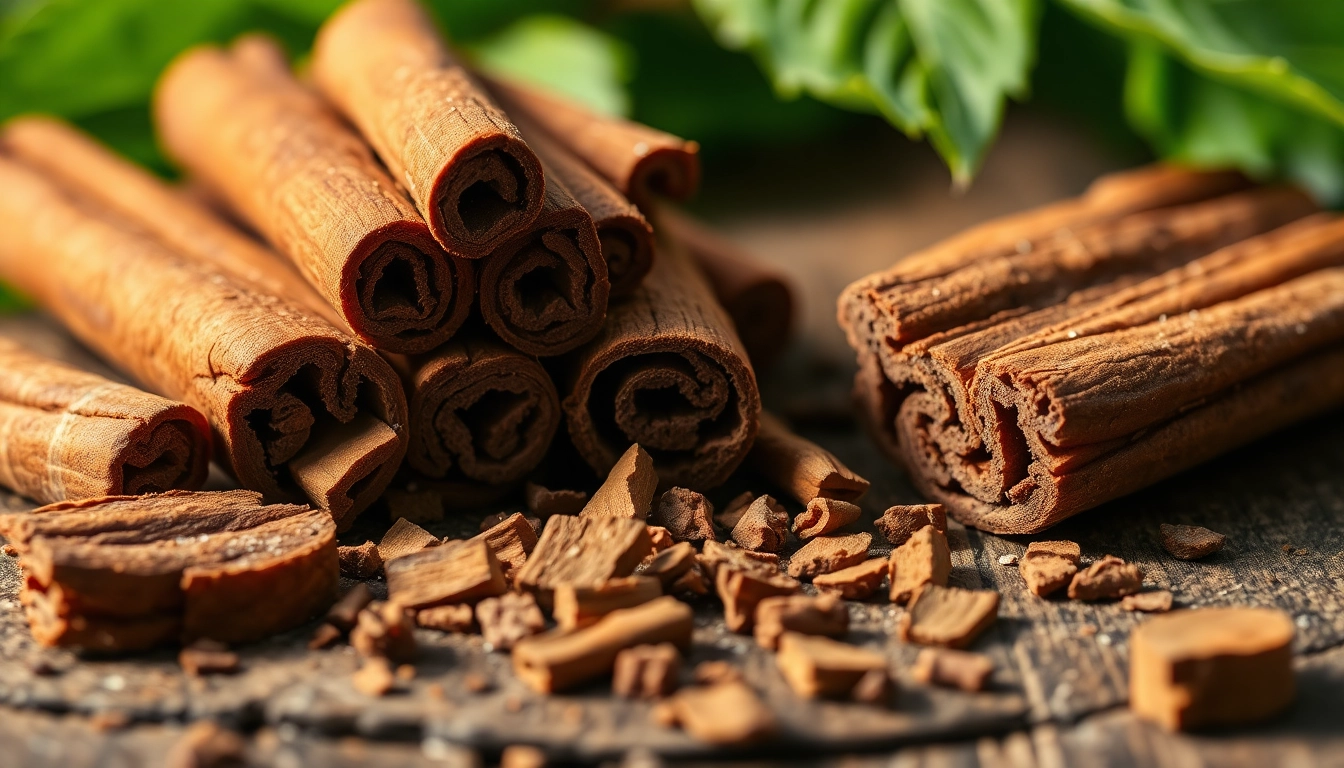Understanding Cinnamon Bark
What is Cinnamon Bark?
Cinnamon bark is the aromatic, dried inner bark of trees belonging to the genus Cinnamomum. This spice is lauded not only for its distinct flavor but also for its historical significance and extensive medicinal properties. The bark is harvested by carefully scraping off the outer bark and processing the inner bark, which curls into the familiar quills or sticks when dried. Most commonly, we encounter cinnamon in two primary forms: Ceylon cinnamon, often referred to as “true cinnamon,” and Cassia cinnamon, the more widely consumed variety.
Types of Cinnamon Bark
The two dominant types of cinnamon bark are Ceylon (Cinnamomum verum) and Cassia (Cinnamomum cassia). Ceylon cinnamon is lighter in color, sweeter, and has a more delicate aroma. It is often considered superior due to its lower coumarin content, a compound that may pose health risks in large quantities. Cassia cinnamon, on the other hand, is darker, spicier, and more commonly found in supermarkets across the United States. This version is often labeled simply as “cinnamon.”
Nutritional Profile of Cinnamon Bark
Cinnamon bark is not only celebrated for its unique flavor but also for its impressive array of nutrients and bioactive compounds. A typical serving of ground cinnamon (about one teaspoon or 2.6 grams) contains:
- Calories: 6
- Carbohydrates: 2 grams
- Fiber: 1 gram
- Fat: 0 grams
- Protein: 0 grams
- Manganese: 22% of the RDI
- Calcium: 4% of the RDI
- Iron: 2% of the RDI
Manganese, found in particularly high levels in cinnamon, is essential for metabolism and antioxidant defenses. Cinnamon also contains anti-inflammatory properties and is rich in antioxidants, making it a vital addition to a healthy diet.
Cinnamon Bark in Culinary Applications
Cooking with Cinnamon Bark
Cinnamon bark is utilized in various culinary contexts, ranging from sweet desserts to savory stews. Its distinctive flavor contributes not only to the taste but also to the aroma of dishes. Here are a few ways to incorporate cinnamon bark into your cooking:
- Infusions: Whole cinnamon sticks can be infused into beverages, such as teas and mulled wines, providing a warming aroma and flavor.
- Spice Blends: Ground cinnamon can be combined with other spices to create flavorful rubs for meats or to enhance baked goods.
- Stews and Curries: In many cuisines, particularly in South Asia, cinnamon bark is added to stews and curries to deepen flavor.
Popular Dishes Featuring Cinnamon Bark
Cinnamon bark’s versatility in the kitchen allows it to shine in a variety of dishes:
- Cinnamon Rolled Breads: A breakfast staple, cinnamon rolls are delicious pastries that highlight the aromatic properties of cinnamon bark.
- Chili: A pinch of cinnamon in chili not only enhances the depth of flavor but also offers a unique twist to traditional recipes.
- Apple Pie: This classic dessert is transformed with the addition of cinnamon bark, amplifying the sweet and tart flavors of the apples.
Storage and Preservation Tips for Cinnamon Bark
To maintain the flavor and aroma of cinnamon bark, it’s crucial to store it correctly. Follow these guidelines:
- Dry Conditions: Keep cinnamon bark in a cool, dry place away from sunlight, as humidity and light can diminish its quality.
- Sealed Containers: Store it in an airtight container to prevent moisture and odors from other spices from affecting its flavor.
- Expiration Awareness: While whole cinnamon sticks can last for years, ground cinnamon should be used within six months for optimal flavor.
Health Benefits of Cinnamon Bark
Antioxidant Properties
Cinnamon bark is rich in polyphenol antioxidants, which play a significant role in promoting health. These antioxidants can help reduce oxidative stress in the body, leading to potential benefits such as:
- Reducing Inflammation: Chronic inflammation is linked to numerous health conditions; cinnamon’s antioxidants can help mitigate this risk.
- Support for Heart Health: Antioxidants in cinnamon bark can assist in reducing LDL cholesterol and triglycerides while promoting healthy blood pressure levels.
Potential Blood Sugar Regulation
Several studies suggest that cinnamon bark may help manage blood sugar levels, especially for individuals with type 2 diabetes. This could be attributed to cinnamon’s ability to:
- Increase Insulin Sensitivity: Cinnamon may improve insulin sensitivity, leading to better blood sugar management.
- Slow Down Carbohydrate Breakdown: It can slow the digestion of carbohydrates in the digestive tract, resulting in lower blood sugar spikes after meals.
Digestive Health Benefits
Cinnamon bark has long been used in traditional medicine as a digestive aid. Its potential benefits include:
- Alleviating Gas and Bloating: By relaxing the muscles in the gastrointestinal tract, cinnamon may provide relief from gas and bloating.
- Antimicrobial Properties: Cinnamon has been shown to reduce harmful bacteria and fungi in the stomach, which can contribute to gastrointestinal discomfort.
Precautions and Side Effects of Cinnamon Bark
Common Side Effects
While cinnamon bark is generally safe for most people, excessive consumption can lead to side effects such as:
- Allergic Reactions: Some individuals may experience allergic reactions to cinnamon, which can cause skin irritation or respiratory issues.
- Gastrointestinal Issues: High doses can lead to digestive discomfort, including nausea or oral irritation.
Recommended Dosages
For optimal health benefits, the recommended daily dosage of cinnamon bark varies. While some studies use 1 to 6 grams per day, it’s advisable to consult with a healthcare provider for personalized recommendations based on individual health conditions and dietary needs.
Interactions with Medications
Cinnamon bark may interact with medications, particularly those for diabetes and blood thinners. Consultation with a healthcare professional is recommended before integrating cinnamon bark into your routine if you are on medication to avoid potential interactions.
Where to Buy Quality Cinnamon Bark
Choosing Between Ceylon and Cassia
When purchasing cinnamon, it’s essential to understand the difference between Ceylon and Cassia to make an informed choice. Ceylon is often pricier due to its limited harvest locations and perceived health benefits, while Cassia is more accessible and commonly found in stores. Depending on your culinary needs and health beliefs, you may opt for one over the other.
Reputable Brands for Purchase
Choosing high-quality cinnamon is crucial for both flavor and health benefits. Some reputable brands include:
- McCormick: Known for its reliable spices, McCormick offers both ground and whole cinnamon options.
- Simply Organic: This brand is praised for its organic cinnamon products, free from additives.
- Penzeys Spices: Renowned for quality, Penzeys offers various cinnamon options, including Ceylon and Cassia.
Online and Local Retail Options
Cinnamon bark can be purchased both online and in local stores. Websites like Amazon, iHerb, and specialty spice retailers offer a wide selection. In local grocery stores, you can often find it in the spice aisle, but checking for high-quality brands ensures better flavor and potency. For a unique twist, consider trying Cinnamon Bark sourced from high-quality suppliers.



